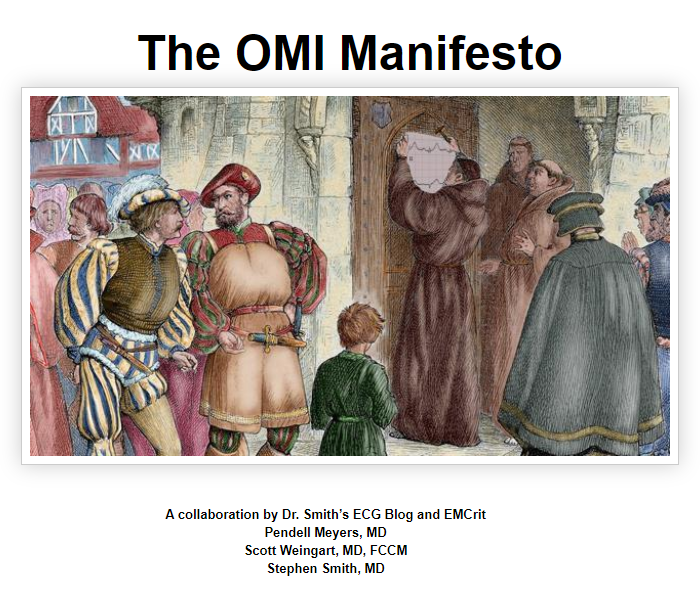OMI stands for Obstructive Myocardial Infarction.
The Omi Manifesto Lecture by Pendell Meyers on YouTube, 53:47. June 27, 2019.
Here is Dr. Meyers post on The OMI Manifesto from Dr. Smith’s ECG Blog:
The current guideline-recommended paradigm of acute MI management (“STEMI vs. NSTEMI”) is irreversibly flawed, and has prevented meaningful progress in the science of emergent reperfusion therapy over the past 25 years. Dr. Stephen Smith, my mentor and co-editor of this post, has been saying this much more eloquently for many years in his “STEMI/NSTEMI False Dichotomy” lecture series, but this bears repeating and needs to be reiterated as widely as possible.
Deciding which patients need emergent reperfusion therapy is complex, and our current criteria for doing so are not adequate to the task. The patients who benefit from emergent catheterization are those with acute coronary occlusion (ACO) or near occlusion, with insufficient collateral circulation, whose myocardium is at imminent risk of irreversible infarction without immediate reperfusion therapy. This is the anatomic substrate of the entity we are supposed to refer to as “STEMI.” Unfortunately the term “STEMI” restricts our minds into thinking that ACO is diagnosed reliably and/or only by “STEMI criteria” and the ST segments. In reality, the STEMI criteria and widespread current performance under the current paradigm have unacceptable accuracy, routinely missing at least 25-30% of ACO in those classified as “NSTEMI”1-9 and generating a similar false positive rate of emergent cath lab activations.10-12
The STEMI-NSTEMI paradigm was the best idea available in 2000, when it formally replaced the Q-wave vs. Non-Q-wave MI paradigm.13 This paradigm shift was prompted by the Reperfusion Era, in which multiple large randomized controlled trials proved the efficacy of emergent reperfusion therapy.14 More specifically, nearly 60,000 ACS patients were randomized to thrombolytics vs. placebo, showing an impressive mortality benefit of NNT=56 for entire cohort given thrombolytics, despite the fact that 4 of the 9 trials had no ECG inclusion criteria whatsoever, and one-third of the patients had no appreciated STE. In the subgroup with undefined STE, lytics showed an even greater mortality benefit of NNT=43. This means that STE predicted ACO (and thus mortality benefit) better than not looking at the ECG at all. However, thanks to Dr. Smith and others we have learned a great deal about expert ECG interpretation since the 1994 FTT meta-analysis, and it turns out STE is no longer our best option for predicting ACO and therefore of the benefit from emergent reperfusion.
To anyone who has spent time seeing patients and studying the ECGs and angiograms of acute MI, it is obvious why the STEMI criteria routinely fail in both directions. Foremost, ACO is a complex and dynamic process that doesn’t always manifest any ECG changes at all. When it does manifest ECG changes, it is an intricate and time-sensitive progression of changes, exquisitely sensitive to reperfusion and reocclusion. The earliest stages of ACO (when the benefit of intervention is maximal) routinely do not show any STE. Even if you are lucky (or wise) enough to obtain an ECG during the ST segment changes, STE is always proportional to the size of the QRS complex, which may be very small in some territories with low voltage on the surface ECG such as the high lateral wall. Furthermore, not all ACOs produce STE, some result only in changes in the QRS or T-wave, or no ECG findings at all. This may be due to a variety of causes: time of recording (including during a brief period of spontaneous reperfusion), “electrocardiographically silent” myocardial territory, small myocardial territory, and low QRS voltage. Meanwhile, a huge proportion of controls without acute coronary syndrome have normal variant STE, or have abnormal depolarization (LVH for a common example) generating appropriate repolarization abnormalities which frequently meet STEMI criteria.
OMI = Occlusion Myocardial Infarction
NOMI = Non-Occlusion Myocardial Infarction
To learn the history, literature, and experience that supports these views, as well as the reasons we propose OMI, follow the link below to the full PDF manuscript of the OMI Manifesto……………………
This is a detailed document with many references that are described in detail:





